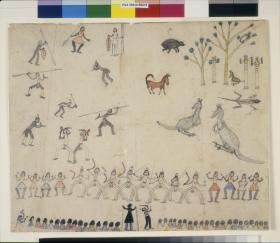Making sense of a changing world
The making of the modern world from 1750 to 1918. It was a period of industrialisation and rapid change in the ways people lived, worked and thought. It was an era of nationalism and imperialism, and the colonisation of Australia was part of the expansion of European power.
Key inquiry question #1
How did new ideas and technological developments contribute to change in this period?
Content summary
The extension of settlement, including the effects of contact (intended and unintended) between European settlers in Australia and Aboriginal and Torres Strait Islander peoples (ACDSEH020)
Students:
- use a range of sources to describe contact experiences between European settlers and Indigenous peoples
In this unit of work the term 'Indigenous' is used to refer to Aboriginal and Torres Strait Islander people.
Background Notes for Teachers
Teachers should be aware that, in some Aboriginal and Torres Strait Islander Communities, hearing names or seeing images of deceased persons may cause sadness or distress, particularly to the relatives of these people.
Inquiry question: What do the drawings of Mickey of Ulladulla tell us about how life changed for Aboriginal people as the result of British colonisation?
The changing world of Mickey of Ulladulla
This is a drawing by an Aboriginal man known as Mickey of Ulladulla. Mickey was born on the south coast of New South Wales nearly 200 years ago. He was a member of the Dhurga people. People who knew Mickey described him as being disabled; he probably needed to use sticks or crutches to help him walk.
The first European settlers came to the area around 1828 when Mickey was a young boy. When Europeans came to live in this area they changed the way Aboriginal people lived. Mickey drew these pictures in the 1870s and 1880s, when he was around 50 to 60 years old.
Mickey's drawings show how Aboriginal life changed during his lifetime. Aboriginal people are shown wearing European-style clothes and hats. They are fishing from European-style boats, cook in European-style pots and making items for Europeans to purchase. Mickey's drawings are a powerful record seen through Aboriginal eyes of how Aboriginal life changed after European settlement.
Additional information about Mickey can be found at:
Student Activities
Mickey of Ulladulla
Students analyse the drawings by Mickey of Ulladulla and investigate how life changed for Aboriginal people as a result of British colonisation.

NSW Syllabus for the Australian Curriculum History K - 10
A student:
- HT5-1 explains and assesses the historical forces and factors that shaped the modern world and Australia
- HT5-2 sequences and explains the significant patterns of continuity and change in the development of the modern world and Australia
- HT5-7 explains different contexts, perspectives and interpretations of the modern world and Australia
- HT5-9 applies a range of relevant historical terms and concepts when communicating an understanding of the past
- HT5-10 selects and uses appropriate oral, written, visual and digital forms to communicate effectively about the past for different audiences
Students:
Comprehension: chronology, terms and concepts
- read and understand historical texts
- use historical terms and concepts in appropriate contexts (ACHHS165, ACHHS183)
Analysis and use of sources
- identify different types of sources
- process and synthesise information from a range of sources as evidence in an historical argument (ACHHS170, ACHHS188)
Perspectives and interpretations
- identify and analyse the reasons for different perspectives in a particular historical context (ACHHS172, ACHHS173, ACHHS190, ACHHS191)
Empathetic understanding
- interpret history within the context of the actions, values, attitudes and motives of people in the context of the past (ACHHS172, ACHHS173, ACHHS190, ACHHS191)
Research
- ask and evaluate different kinds of questions about the past to inform an historical inquiry (ACHHS166, ACHHS167, ACHHS184, ACHHS185)
- plan historical research to suit the purpose of an investigation
- identify, locate, select and organise information from a variety of sources, including ICT and other methods (ACHHS168, ACHHS186)
Explanation and communication
- develop historical texts, particularly explanations and historical arguments that use evidence from a range of sources (ACHHS174, ACHHS188, ACHHS192)
- Continuity and change: some aspects of society, event or development change over time and others remain the same
- Perspectives: people from the past may have had different views and experiences
- Significance: the importance of an event, development, group or individual and their impact on their times and/or later periods
- Contestability: how historians may dispute a particular interpretation of an historical source, event or issue
Learning across the curriculum
- Aboriginal and Torres Strait Islander histories and cultures
- Ethical understanding
- Literacy
- Intercultural understanding